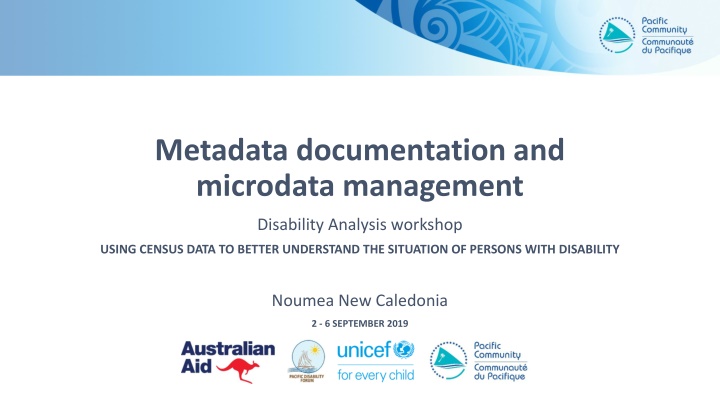
Disability Data Using Census Information
Enhance statistical data production for policy-making with a focus on document management and microdata analysis to improve understanding of disability situations. Learn the benefits of data dissemination and the importance of statistical principles.
Download Presentation

Please find below an Image/Link to download the presentation.
The content on the website is provided AS IS for your information and personal use only. It may not be sold, licensed, or shared on other websites without obtaining consent from the author. If you encounter any issues during the download, it is possible that the publisher has removed the file from their server.
You are allowed to download the files provided on this website for personal or commercial use, subject to the condition that they are used lawfully. All files are the property of their respective owners.
The content on the website is provided AS IS for your information and personal use only. It may not be sold, licensed, or shared on other websites without obtaining consent from the author.
E N D
Presentation Transcript
Metadata documentation and microdata management Disability Analysis workshop USING CENSUS DATA TO BETTER UNDERSTAND THE SITUATION OF PERSONS WITH DISABILITY Noumea New Caledonia 2 - 6 SEPTEMBER 2019
Goal and Objectives To strengthen country capacity in producing statistical data relevant for policy design, monitoring and evaluation, by : Better documenting, preserving, anonymizing and disseminating existing microdata 1 Better exploiting existing datasets (quality assessments, further analysis) 2
Why document? Why disseminate? Why document? Why disseminate? Why document? Why disseminate? Why document? Why disseminate?
Benefits of dissemination Diversity of research work. Data producers usually publish tabular and analytical outputs. But they will never identify all the research questions that can be addressed using the data. Most data can be re- purposed , i.e used for other purposes than the one(s) for which they were collected. Microdata dissemination encourages diversity (and quality) of analysis. "The data cannot be exhausted no matter how much they are used; their use by one person does not in the least affect the potential of their further use by others". (Rockwell) Credibility/acceptability of data. Broader access to microdata demonstrates the producer s confidence in the data, by making replication (or correction) possible by independent parties. Reduced duplication. Non accessibility to microdata forces users to conduct their own surveys. Microdata dissemination would reduce the risk of duplicated activities.
Benefits of dissemination (continued) Harmonization and comparability. By reducing duplicated or competing data collection and allowing all users to access the same data, microdata dissemination reduces inconsistencies in methods and results. Better policies and programs. The development of evidence-based policies require far more detailed analysis than typically produced by statistical agencies that collect data. Funding. Better use of data means better return for survey sponsors, who will thus be more inclined to support data collection activities. Increasingly, funding of surveys by international sponsors is subordinated to dissemination of the resulting datasets. Quality of data. It is often through the use of data that insights for improvement for survey design can be identified.
Fundamental principles of statistics The United Nations Fundamental Principles of Statistics provide a basis for many legislations. Individual data collected by statistical agencies for statistical compilation, whether or not they refer to natural or legal persons, are to be strictly confidential and used exclusively for statistical purposes United Nations Fundamental Principle of Official Statistics, Article 6 The UNECE Task Force on Data Dissemination suggests four principles to reconcile this Fundamental Principle with microdata dissemination. http://www.unece.org/stats/documents/tfcm/1.e.pdf
Should microdata be disseminated? Yes Within the framework of an enabling legislation. Following a formal and transparent policy and procedures, which define who has access to what, how, and under what conditions. With the understanding that some data may be highly sensitive and require some restrictions and strict conditions to their access.
Fundamental principles of statistics Principle 1: It is appropriate for microdata collected for official statistical purposes to be used for statistical analysis to support research as long as confidentiality is protected (i.e. as long as it is not possible to identify data referring to an individual). Principle 2: Microdata should only be made available for statistical purposes. Principle 3: Provision of microdata should be consistent with legal and other necessary arrangements that ensure that confidentiality of the released microdata is protected. Principle 4: The procedures for researcher access to microdata, as well as the uses and users of microdata should be transparent, and publicly available.
Standardised platform to document collections + mechanism for microdata access. 570 survey datasets documented Maintenance of over 900 citations Various access policies: Public use files, licensed data, links to external repositories Interaction with users is a very low burden Fully positive experience Documentation and metadata facilitates comparison of combination of countries or census/survey years
Variable Level Summary Statistics Detailed Variable Level Metadata
